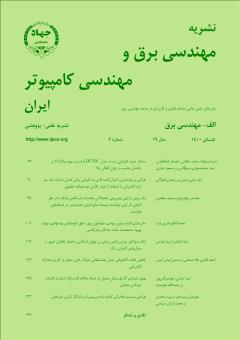طراحی سیستم مخابراتی تغذیهشده بیسیم با برداشتگر انرژی غیر خطی
محورهای موضوعی : مهندسی برق و کامپیوترمهرنوش میرحاج 1 , مریم مسجدی 2 , محمدفرزان صباحی 3
1 - موسسه صفاهان
2 - مؤسسه آموزشی صفاهان
3 - دانشگاه اصفهان
کلید واژه: برداشت انرژی, شبکههای مخابراتی تغذیهشده بیسیم, برداشتگر انرژی غیر خطی, جهتدهی پرتو انرژی, سیستم چندورودی- چندخروجی,
چکیده مقاله :
در این مقاله، یک شبکه مخابراتی تغذیهشده بیسیم چندکاربره در نظر گرفته شده که در آن کاربران و ایستگاه پایه ترکیبی به چند آنتن مجهز هستند. در فاز فروسو، ایستگاه پایه ترکیبی، سیگنال انرژی را برای کاربران ارسال کرده و در فاز فراسو، کاربران با استفاده از انرژی برداشتشده در فاز قبل، اطلاعات خود را با استفاده از فناوری دسترسی چندگانه فضایی به ایستگاه پایه ترکیبی ارسال میکنند. با در نظر گرفتن مدل عملی غیر خطی برای برداشتگر انرژی و با هدف بیشینهکردن مجموع نرخ، روشی بهینه را برای طراحی ماتریس پیشکدگذار انرژی، ماتریسهای پیشکدگذار اطلاعات کاربران و زمان اختصاصیافته به فاز فروسو و فراسو پیشنهاد میدهیم. به این منظور با استفاده از تغییر متغیرهای مناسب، مسئله را به صورت یک مسئله بهینهسازی محدب بازنویسی کرده و روشی برای حل آن ارائه میکنیم. نتایج شبیهسازی نشان میدهند که در شرایط عملی، با لحاظ رفتار غیر خطی برای برداشتگر در طراحی، انرژی ارسالی کاهش و مجموع نرخ افزایش مییابد.
In this paper, a wireless powered communication network (WPCN) is considered, in which the hybrid access point (HAP) and the users are equipped with multiple antennas.In the downlink phase, an energy HAP transfers the energy signal to the users and in the uplink phase, users apply the harvested energy to transfer their information to the HAP using spatial division multiple access (SDMA) technology. By considering the nonlinear behavior of energy harvester in system design and aiming to maximize the sum of the rates, we propose an optimal method for designing energy pre-coding matrices, user information pre-coding matrices, and time devoted to the downlink and uplink phases. For this purpose, we rewrite the problem as a convex optimization problem by appropriate change of variables and propose a method to solve it. The simulation results show that in practical scenarios, employing the nonlinear energy harvesting model in the system design could reduce the transmitted energy, increase and the sum rate of the users.
